Joyce Biographies: James Joyce
- At May 29, 2022
- By Great Quail
- In Joyce
 0
0
Nay, more, were I not all I was,
Weak, wanton, waster out and out,
There would have been no world’s applause
And damn all to write home about.
—James Joyce, Epilogue to Ibsen’s “Ghosts”
Joyce Biography: James Joyce
This page offers a profile of the major James Joyce biographies, listed by publication date. Clicking a cover image takes you to Amazon.com. When Brazen Head commentary is unavailable, the publisher’s summaries are usually reprinted. If any knowledgeable Joyce reader would like to review, summarize, or provide additional information for any of these “uncommented” books, please drop us a line! Additional Joycean biographies may be found by clicking the links below:
Joyce Biography
[Main Page | Biographical Sketch | Chronology | Joyce Biographies | Family & Associates | Memoirs & Photos | Letters | Dublin]
James Joyce: His First Forty Years
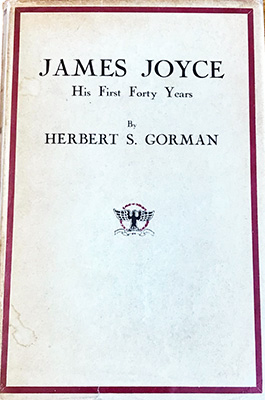
James Joyce: His First Forty Years
By Herbert S. Gorman
B.W. Huebsch, 1924
Current: Hassell Street Press, 2021
Available online at: Internet Archive
Herbert Sherman Gorman (1893-1954) was a Massachusetts-born editor, writer, and book reviewer. He lived in Greenwich Village, where his circle of friends included Stephen Vincent Benét, Theodore Dreiser, and Sinclair Lewis. Known for his historical novels, Gorman’s most famous book was The Scottish Queen (1932), a fictionalized life of Mary Queen of Scots. He also wrote The Place Called Dagon (1927), an early work of weird fiction mentioned by H.P. Lovecraft in his seminal Supernatural Horror in Literature, and believed to have influenced Lovecraft’s own fiction.
Widely recognized as James Joyce’s earliest biographer, Gorman’s first book about Joyce was James Joyce: His First Forty Years, which combined biography and commentary about Dubliners, Portrait, and Ulysses. (He spends a lot of time summarizing Ulysses, which was still unavailable to most of his readers!) Joyce was pleased by Gorman’s work, and mailed him a list of “rectifications” for the upcoming UK edition to be published by Geoffrey Bles. Although these corrections were ultimately not incorporated into the 1926 printing, Gorman worked closely with Joyce to publish a proper biography in 1939. (Visitors interested in Gorman and Joyce’s working relationship are directed to Hugh Witemeyer’s “He Gave the Name,” published in the James Joyce Quarterly.)
James Joyce
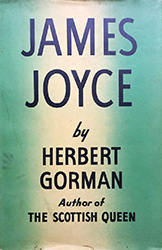
James Joyce
By Herbert S. Gorman
First Edition: Farrar & Rinehart, 1939
(Some 1940s editions bear the title, James Joyce: A Definitive Biography)
Available online at: Internet Archive
Herbert Gorman’s second biography of James Joyce was published shortly before Joyce’s death. More complete than His First Forty Years, this biography was written with direct input from Joyce himself. As Gorman writes in his acknowledgments, “To James Joyce himself I am indebted for his patience in answering questions, his calm unconcern for my deductions and assumptions and his permission to print unpublished or rare writings by him. To the graciousness of Mrs. James Joyce I incline an admiring head.” This “unpublished material” includes Joyce’s translation of Gottfried Keller’s poem, “Now have I fed and eaten up the rose.”
More a novelist than a biographer, Gorman employs a writerly approach to Joyce’s life that often reads like fiction. Here’s a paragraph that sets the scene for Joyce’s birth:
In 1882 Rathgar was even closer to the febrile mythos of a self-contained Old Ireland than it had ever been. A high anticipation of being master in one’s own house permeated the rainy atmosphere that lowered above the Liffey. Men congregated in inns, in public houses, on street corners and violently discussed the dawn of a new James Joyce era. The spirits in the soil were twitching their long armoured limbs. It was a murky dawn, at best, but the ray of light was there, falling as though through a scarcely-opened door and evident to eyes almost too passionate to see. The battle cry (and Irishmen must always have battle cries) was Home Rule. The Leader (and Irishmen must always have leaders if only to betray them) was Charles Stewart Parnell, a man without a drop of Irish blood in his body. He was a new leader (successor to the impotent Isaac Butt) and at the moment he was incarcerated in Kilmainham Jail, but behind prison bars or out his was the shoulder that was pushing back that scarcely-opened door. On Dublin street corners ragged red-necked ballad singers were bawling:
Come, all ye gallant Irishmen, and listen to my song,
Whilst I a story do relate of England’s cruel wrong.
Before this wrong all other wrongs of Ireland do grow pale,
For they’ve clapped the pride of Erin’s Isle into cold Kilmainham Jail.
This colorful style informs the entire biography, which invests the twist and turns of Joyce’s complicated life with Shakespearean drama. While “hagiography” might be a strong word, there’s no question that Gorman believes in Joyce’s inherent greatness. Gorman frames Joyce as a misunderstood genius, a valiant hero struggling against the forces of philistinism and repression. While there’s certainly some truth to that, and it’s undeniably part of the Joyce mythos, Gorman’s lack of balance transforms Joyce from subject to protagonist—another aspect of James Joyce that feels more “literary” than “biographical.” At times, this abundance of sympathy spills over into awkward gushing. For example, here are Gorman’s concluding paragraphs, in which Joyce is described dancing at a Parisian soirée:
No one who has not seen Joyce dance can have any idea from a brief description what his terpsichorean talents are like. To enlivening music he breaks into a high fantastic dance all by himself, a dance that is full of quaint antics, high kicks and astonishing figures. He dances with all his body, head, hands and feet and the evolutions, through which he goes, eccentric but never losing the beat of the music, are calculated to arouse a suspicion in the beholder that he has no bones at all. Others join in the dances and he weaves wild and original patterns with them. When the music stops he sinks contentedly into his chair. The festival has been a success.
It is after midnight when the moment for parting (delayed as long as possible) comes. Joyce stands by his door bidding good night to his guests, and as they depart down the stairs and into the night they glance back and see standing above them the tall lean figure of a great gentleman and a great writer.
It’s all a bit much, and modern readers may prefer more objectivity than Gorman is prepared to offer. Still, it’s this dramatic style that makes James Joyce unique. As long as the reader understands its foibles, James Joyce makes an engaging and pleasant read, an historical curiosity eclipsed by Richard Ellmann’s 1959 biography of the same name.
Joyce: The Man, the Work, the Reputation
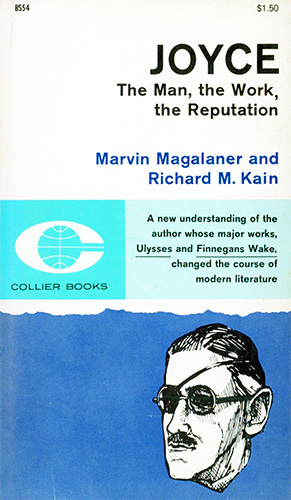
Joyce: The Man, the Work, the Reputation
By Marvin Magalaner & Richard M. Kain
University Press, 1956
Available online at: Internet Archive
Part biography, part critical appraisal, and part analysis of the burgeoning Joyce industry, the purpose of this book is explained by the authors’ preface:
With his first major work appearing on the eve of the First World War and his last on the eve of the Second, James Joyce has seemed a symptom and portent of our age. At the same time he has challenged and delighted readers, scholars, critics, and artists with his verbal magic and unique vision. If the discovery of Joyce has at times been a grim work in progress, it is also a fascinating search, a second Quest for Corvo, as the Dublin Joycean, Niall Sheridan, has suggested. The authors of this volume feel that the time has come to appraise the position of Joyce in the modern world. Though it is manifestly impossible to cover all the relevant material, the volume may provide something for beginners and advanced Joyceans alike.
But if no single volume can say the last word about Joyce, our analyses of his works attempt merely to discover a way of approach to what he wrote, to suggest a method of reading Joyce that will be profitable and exciting. The elaborate paraphrase of a “skeleton key” is not needed to accomplish this, nor must critical exegesis exhaust the possibilities of every paragraph Joyce wrote. Yet, at the same time, we hope that the avenues opened by our exploratory analyses will lead easily to further, extended insights. In similar fashion, we have not tried to do again the biography of Joyce. In a few pages, we discuss only those categories of Joyce’s life in which there has hitherto appeared to be confusion. In “The Joyce Enigma” and “The Problem of Biography,” we seek to identify the points of dispute, and, if we can, illuminate cloudy places. These chapters should be looked upon principally as points of departure for further investigation.
What, then, does the book do? It is the first extended treatment of the history of Joyce’s critical reputation. Making use of hundreds of books and articles—many unavailable except in private collections here and abroad—it seeks to show what the twentieth century has thought of this strange Irishman over the years. As a corollary to this broad treatment of Joyce’s reputation, the book is able to bring together in one volume, for the first time, the best criticism available on each of Joyce’s major works. This criticism, scattered in esoteric journals, little magazines, out-of-print books, rare collectors’ items, and foreign periodicals, is often out of reach of the student. Such critical opinion and analysis, supplemented by our own researches, should offer a useful addition to the literature on Joyce. We have tried to stress those aspects of his life and work often treated casually. That is why we allot so much space to the generally slighted short stories of Dubliners. That is why, for instance, we have included excerpts from Joyce’s as yet unpublished letters and have given a large share of attention to the relationship of Joyce to the modern arts.
James Joyce
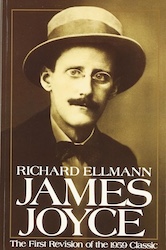
James Joyce
By Richard Ellmann
First Edition: Oxford University Press, 1959
Revised Edition: Oxford University Press, 1982
Available online at:Internet Archive
Also available as: Audible Audiobook
Born in Michigan, educated at Yale, made a fellow at Oxford, Richard David Ellmann (1918-1987) was one of the twentieth-century’s most accomplished scholars of Irish literature. Although he turned to Oscar Wilde during his last decade of scholarship, Ellmann’s name is inextricably linked to the Golden Age of Joyce studies: he has introduced, organized, and edited dozens of Joyce-related texts, including Stanislaus Joyce’s biography of Joyce, three volumes of Joyce’s letters, Gisèle Freund’s photographic memoir of Joyce in Paris, and the first publication of Giacomo Joyce. Ellmann also served as the arbiter in charge of final editorial selections for the revised 1960s editions of Dubliners and A Portrait of the Artist as a Young Man, and worked closely with the Joyce Estate to oversee the 1980s Gabler edition of Ulysses. But Ellmann’s greatest achievement is James Joyce, his 1959 biography.
Often cited as the greatest literary biography of the twentieth century, James Joyce is an exhaustively-researched book, weighing in at 842 pages—longer than Ulysses itself. Ellmann was inspired to write the biography in 1947, when William Butler Yeats’ widow, Georgie Hyde-Lees, showed him an unpublished preface in which Yeats described first meeting Joyce. Ellmann spent the next twelve years working on the book, traveling across Ireland and Europe and interviewing Joyce’s surviving family, friends, and associates. Also neighbors, shopkeepers, cabbies, dogs and cats—pretty much anyone who might have bumped into Jim one time or another! James Joyce was published in 1959, and won the National Book Award in Nonfiction. In 1982, a “New and Revised Edition” was published. As Ellmann described in his new preface:
I have incorporated the considerable amount of new information that has come in during the twenty-two years since it was published. The additions may help to assuage some of the curiosity that still persists about this bizarre and wonderful creature who turned literature and language on end. In what follows readers of the first edition will discover that more pages have been altered than not, by insertions ranging from a line to a page or more. The fresh material deals with most aspects of Joyce’s life: his writings and his attitude towards them, his experiences of love and desire, his domestic travails, his political views. Many corrections (besides those entered on two occasions in earlier printings) have also been made… In the second edition, as in the first, I have followed Joyce’s own prescription of total candor, with the knowledge that his life, like Rousseau’s, can bear others’ scrutiny as it bore his own. In working over these pages, I have felt all my affection for him renewed.
Although the intervening years have exposed many of Ellmann’s errors, assumptions, and misinterpretations, James Joyce is still the standard by which other Joyce biographies are measured. Indeed, most subsequent biographies generally position themselves in reference to James Joyce, whether described as “supplements,” “updates,” or “newly-researched” areas uncovered by Ellmann. Despite its occasional flaws, Ellmann’s biography belongs on every serious Joyce shelf.
My Brother’s Keeper: James Joyce’s Early Years
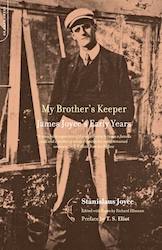
My Brother’s Keeper: James Joyce’s Early Years
By Stanislaus Joyce. Edited by Richard Ellmann
Introduction by T.S. Eliot
First Edition: University Press, 1958
Current: DeCapo, 2003
Available online at: Internet Archive
This biography of Joyce was written by his brother Stanislaus. It mainly covers his early life—the period memorialized in Stephen Hero and A Portrait of the Artist as a Young Man—and offers many fascinating details about the Joyce family in Dublin and James and Nora in Trieste. Stanislaus paints a fair, though not always sympathetic, portrait of his older brother, who emerges as an intelligent but arrogant young man who frequently placed his family second.
Publisher’s Description: Stanislaus Joyce was more than his brother’s keeper: he was at various times his brother’s co-dependent, touchstone, conscience, and biggest fan. The two shared the same genius, the same childhood influences, and had the same literary instinct, but in Stanislaus it was channeled into sober academic pursuit, while in James it evolved into gaiety, wild whimsy, and at times sodden despair. Covering the first twenty-two years of James Joyce’s life in Dublin and Trieste, My Brother’s Keeper is a window onto the drama that was his youth. Thanks to Stanislaus’s superb memory and sure hand, here we find the Dublin of Dubliners: the streets, neighbors, churches, and unforgettable eccentrics. Here we see the model for Ulysses’ Simon Dedalus: James’ father, a dour and violent figure when in his cups. Here are the Joyces in their own home, and the minor characters that pepper A Portrait of the Artist: Eileen, Leopold Bloom’s comely daughter; Mrs. Riordan, the surly teacher; Mr. Casey, the political agitator. And finally, here is Trieste, a place of exile for Stanislaus but a retreat for James. Stanislaus Joyce has fashioned both an invaluable primary source for his brother’s opaque masterpieces and a loving memoir of his brother’s early life.
James Joyce and His World
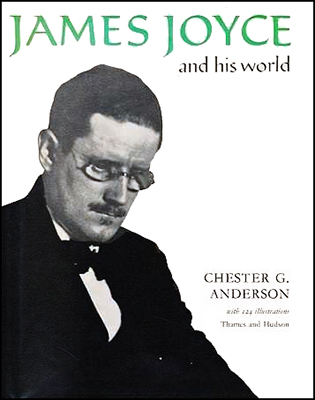
James Joyce and His World
By Chester G. Anderson
Thames and Hudson, 1968
James Joyce (Literary Lives)
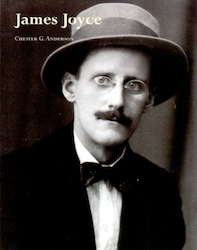
James Joyce (Literary Lives)
By Chester G. Anderson
Thames and Hudson, 1998
A professor at the University of Minnesota, Chester Grant Anderson (1923-2006) earned his doctorate from Columbia University by suggesting “an extensive list of possible corrections” for A Portrait of the Artist as a Young Man. He was promptly appointed editor of that exact project, producing the 1964 “corrected” text under the watchful eye of Richard Ellmann. In 1968 Anderson published James Joyce and His World, a modest-sized biography for those less willing to tackle Mount Ellmann. The book was reprinted in 1978, then reissued in 1998 as James Joyce (Literary Lives).
Publisher’s Description: James Joyce remains a mysterious figure, and yet his books concern his own life: his friends, loves, and, above all, the city of Dublin. Professor Chester Anderson here examines Joyce as one of the great modern writers, but also explores his life, visiting all the places where he lived and worked, and showing how closely these biographical details are related to Joyce’s four great books: Dubliners, A Portrait of the Artist as a Young Man, Ulysses, and Finnegans Wake. This unity of work and life is illuminated by passages quoted from these masterpieces and from Joyce’s letters and other writings. The photographs of Joyce, his family, and surroundings cover every phase of his life.
James Joyce: A Portrait of the Artist
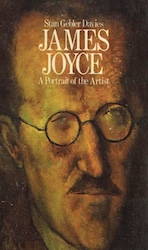
James Joyce: A Portrait of the Artist
By Stan Gébler Davies
Davis-Poynter, 1975
Available online at: Internet Archive
Stan Gébler Davies (1943-1994) was a Dublin-born journalist who wrote for the Irish Independent and numerous British magazines, including Punch. A staunch Unionist, Davies ran unsuccessfully for office in the 1980s. In one of the most colorful obituaries I’ve ever read in a major newspaper, the Independent claimed Davies “belonged to a breed that one no longer encounters, a rake-hell, rumbustious, very Irish, journalist of great charm, who loved to shock, but who was held in almost equally high affection by those he aggravated as by his friends.” In 1975 Davies wrote a biography of James Joyce intended for non-academics—indeed, his hilariously combative preface draws a sharp distinction between himself and the Joyce industry:
Well now, if you are to be a serious student of Joyce, you must read Professor Ellmann. He will tell you why Stephen Dedalus picks his nose and why Molly Bloom menstruates, whereas I can only surmise, being an ignorant Irishman, that Stephen picked his nose because it itched and Molly menstruated because it was her time of the month.
Davies continues, making it clear that his goal is to paint a more grounded portrait of Joyce:
I set out to be the first Irishman to tell the story of Joyce’s life and the English have more or less thanked me for the effort, this being the third edition to appear here (each better than the last). The man had an interesting life, which most men do who have an abiding interest in women, drink, high art and the operation of their own genius. He wrote the greatest novel of our century. I mean Ulysses. I have been criticized for it, but I cannot tell you why it is the greatest novel of the century. Ellmann, it is said, can. I can only tell you to read it. I take the trouble in this book to explain some of its obscurities. They are not in any case sufficient to detract from the overwhelming impression of greatness and wholeness.
For Davies, Joyce was great despite his penchant for experimental narratives, not because of them. In fact, he makes his distaste of Finnegans Wake quite evident, referring to it as the “apotheosis of the crossword puzzle.”
Unsurprisingly, James Joyce: Portrait of an Artist is rarely mentioned among “scholarly” Joyce biographies, and has been out of print since 1982. (It probably didn’t help that Davies spends half his introduction talking about Joyce’s dirty letters and taking giddy potshots at the Joyce Estate!) Davies’ biography is certainly no Ellmann, but it’s more substantial than most “reader’s introductions,” and Davies did coax interviews out of Joyce’s surviving associates such as Arthur Power and Frank Budgen. As Davies himself acknowledges, James Joyce: Portrait of an Artist may not be the first choice for the “serious” student, but it’s hard to find a biography of Joyce that’s more fun, and Davies’ witty irreverence is a welcome antidote to the ponderous sincerity of far too many biographers.
James Joyce (Gill’s Irish Lives)
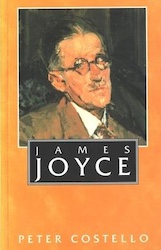
James Joyce (Gill’s Irish Lives)
By Peter Costello
Gill & Macmillan, 1980
Born in Dublin in 1946, Peter Costello is an Irish writer whose interests range from Sherlock Holmes to the mythology of lake monsters. He has written numerous books about James Joyce, mostly specializing in Joyce’s early life and immediate family. He’s also written a novel about Leopold Bloom. This is his first book about James Joyce, written for the “Gill’s Irish Lives” series published by Gill & Macmillan. Like all the books in this series, James Joyce is brief, easy to read, and covers the essential details.
Note: Several online sources erroneously borrow the publisher’s description of Costello’s James Joyce: The Years of Growth to describe this earlier book. While there’s naturally some shared material between the two, they are different books.
James Joyce: The Years of Growth 1882-1915
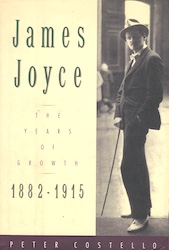
James Joyce: The Years of Growth 1882-1915
By Peter Costello
Pantheon, 1992
Available online at: Internet Archive
In 1980, Irish writer Peter Costello produced a brief biography of Joyce for the “Gill’s Irish Lives” series. Twelve years later he published a more comprehensive and researched biography: James Joyce: The Years of Growth 1882-1915. Probably the most significant contribution to Joyce biography since Ellmann’s James Joyce, Costello’s book contains a substantial amount of “new” material, and remains one of the more important Joyce biographies written by a non-academic. As Costello remarks in his introduction:
I do not believe that there can be such a thing as a definitive biography, especially of a writer as protean as Joyce. Each biographer merely provides a version of the writer’s life, as it appears to him in the context of his own day and his view of the writer’s time. Each new version provides further definition to parts of a complex picture, fresh aspects of which are revealed all the time. Nevertheless it remains true that there are things we cannot know, and this ignorance affects what we write. Biography remains essentially a form of higher fiction.
Publisher’s Description: This first biography of James Joyce in more than a generation will serve as an important supplement to Richard Ellmann’s famous study, focusing as it does on Joyce’s Irish background and that of his family. Using recently discovered or previously overlooked sources, Peter Costello sheds new light on his subject while bringing Joyce—with both his flaws and his genius—to life in a vivid and memorable manner. The theme of Costello’s biography is the theme of all Joyce’s work—the transformation of raw life into art. There are few writers whose early memories proved to be so rich a mine for the creative imagination that infused their work. In his fiction, Joyce’s genius used the lives of the people close to him in Dublin at the turn of the century—their loves, their feuds, and their struggles to overcome hardship—to create the stories of his work. Costello has unearthed many real-life models for so much of what Joyce was to write in later years—John Casey, Emma Cleary, the Misses Morkan, and many others. Among Costello’s most fascinating revelations is the discovery that one of the most famous characters in twentieth-century fiction, Leopold Bloom, derives not from a Jew but from a Belfast Presbyterian. Costello’s intimate knowledge of the city of Dublin—its culture, history, and politics allows him to place Joyce’s actions, writings, and convictions in their natural setting and to show Joyce, surprisingly, as an Irish cultural nationalist with very firm views about his country’s struggle for independence. With its startling revelations, James Joyce: The Years of Growth 1882-1915 interweaves the many strands of person, place, and time to create a brilliant new portrait of Joyce, the artist and the man. It is a major achievement, essential to our understanding of this towering figure of twentieth-century literature.
James Joyce: A Literary Life
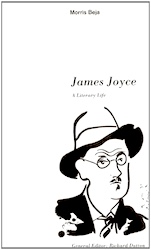
James Joyce: A Literary Life
By Morris Beja
Ohio State University Press, 1992
Available Online at: Internet Archive
One of the most prominent living Joyceans, Morris Beja is currently an emeritus professor at the Ohio State University. A former president of the International James Joyce Foundation, he now serves as an honorary trustee, along with Fritz Senn and Walter Gabler. Beja has been responsible for organizing countless Joyce symposia and Bloomsday celebrations, and edited the James Joyce Newestlatter from 1977 to 2017.
Publisher’s Description: This is a biography of Joyce for the general reader, using material about and by Joyce that has been available for the last two to three decades. James Joyce, arguably the most influential writer of any language in the 20th century, and certainly one of the major figures in world literature, led a fascinating life, and a triumphant and sad one, constantly battling with problems forced upon him as well as those created by him. The author argues that few artists have drawn so heavily on the fabric of their own lives in weaving their fiction. Morris Beja is the author of Epiphany in the Modern Novel and Film and Literature.
James Joyce and Trieste
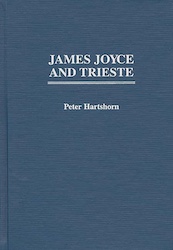
James Joyce and Trieste
By Peter Hartshorn
Praeger, 1997
An English instructor at the Showa Institute for Language and Culture in Boston, Peter Hartshorn has written biographies of James Joyce and Lincoln Steffens. In 2000, Radio Netherlands interviewed Hartshorn in reference to his book, James Joyce and Trieste.
Publisher’s Description: Much attention has been given to Joyce’s life in Dublin and Paris, but his productive years in Trieste have not received the same attention. In a thoroughly documented account, Hartshorn presents a clear, accessible study of Joyce’s love/hate relationship with the city, the work he produced there, and the influence of Trieste on his writing. The book begins with a brief overview of Trieste’s history prior to Joyce’s arrival in 1904, and follows Joyce’s life there until World War I, a period in which he completed Dubliners and A Portrait of the Artist as a Young Man, and began Ulysses. Joyce then departed for the safety of Zurich and the book concludes with his brief return of eight months to Trieste in 1919. Hartshorn has drawn from many previously untapped sources, providing a fascinating look at Joyce’s Trieste years that no other Joyce biographer has yet to reveal.
James Joyce: A Life
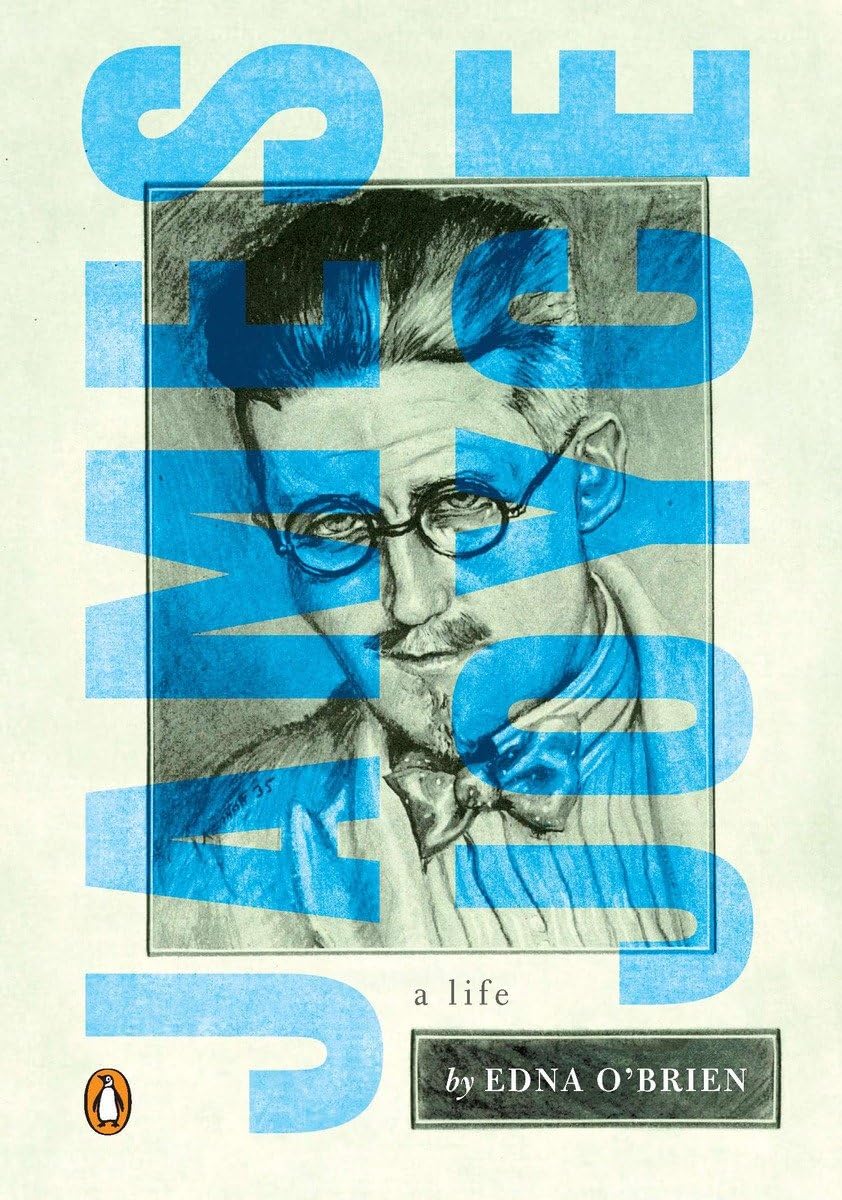
James Joyce: A Life
By Edna O’Brien
Penguin, 1999
Available online at: Internet Archive
Also available as: Audible Audiobook
Part of the “Penguin Lives” series, this biography was written by celebrated Irish novelist Edna O’Brien. A brief work, James Joyce: A Life surveys Joyce’s life and work with an enjoyable prose influenced by Joyce himself. The Brazen Head published a full review of James Joyce in 1999.
Publisher’s Description: Arguably the most influential writer of the twentieth century, James Joyce continues to inspire writers, readers, and thinkers today. Now Edna O’Brien, herself one of Ireland’s great writers, approaches the master as only a fellow countryman can. From Joyce’s adolescence through his travels abroad to the publication of Ulysses—the scandalous masterpiece that was initially banned in the United States but later hailed as one of the most brilliant novels of the twentieth century—O’Brien traces the arc of Joyce’s remarkable life. Her biography is a tribute, at once affectionate and stern, from a contemporary writer to one of our most significant literary ancestors.
James Joyce: A Passionate Exile
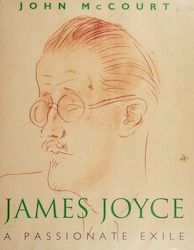
James Joyce: A Passionate Exile
By John McCourt
Thomas Dunne Books, 1999
Available online at: Internet Archive
Having earned his PhD from the National University of Ireland, John McCourt is now a professor at Italy’s Università di Macerata. An internationally-renowned Joycean, McCourt specializes in Joyce’s years in Europe, a subject which has produced two biographies: Passionate Exile and The Years In Bloom.
Publisher’s Description: James Joyce: A Passionate Exile is a revealing new account of the life, times and writings of the twentieth century’s most distinguished novelist. Combining words with an extraordinary collection of contemporary photographs and other images, it depicts his family’s fall from riches to rags and his experience of growing up in late nineteenth century Dublin. Author and Joyce scholar John McCourt also examines Joyce’s relationship with his life-long partner, Nora Barnacle, and casts new light on their 40-year voluntary exile in Europe, first in the cosmopolitan Adriatic port of Trieste, then in lively wartime Zurich and finally in Paris, the artistic centre of the world in the 1920s and 30s.
The Years in Bloom: James Joyce in Trieste
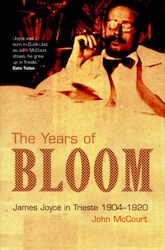
The Years in Bloom: James Joyce in Trieste
By John McCourt
University of Wisconsin Press, 2000
Available online at: Internet Archive
Publisher’s Description: Since the publication of Richard Ellmann’s James Joyce in 1959, Joyce has received remarkably little biographical attention. Scholars have chipped away at various aspects of Ellmann’s impressive edifice but have failed to construct anything that might stand alongside it. The Years of Bloom is arguably the most important work of Joyce biography since Ellmann. Based on extensive scrutiny of previously unused Italian sources and informed by the author’s intimate knowledge of the culture and dialect of Trieste, The Years of Bloom documents a fertile period in Joyce’s life. While living in Trieste, Joyce wrote most of the stories in Dubliners, turned Stephen Hero into A Portrait of the Artist as a Young Man, and began Ulysses. Echoes and influences of Trieste are rife throughout Ulysses and Finnegans Wake. Though Trieste had become a sleepy backwater by the time Ellmann visited there in the 1950s, McCourt shows that the city was a teeming imperial port, intensely cosmopolitan and polyglot, during the approximately twelve years Joyce lived there in the waning years of the Habsburg Empire. It was there that Joyce experienced the various cultures of central Europe and the eastern Mediterranean. He met many Jews, who collectively provided much of the material for the character of Leopold Bloom. He encountered continental socialism, Italian Irredentism, Futurism, and various other political and artistic forces whose subtle influences McCourt traces with literary grace and scholarly rigour. The Years of Bloom, a rare landmark in the crowded terrain of Joyce studies, will instantly take its place as a standard work.
James Joyce in 90 Minutes
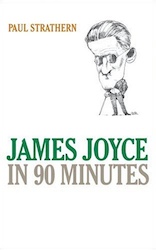
James Joyce in 90 Minutes
By Paul Strathern
Ivan R. Dee, 2005
Also available as: Audible Audiobook | CD
Publisher’s Description: Building on his enormously successful series of Philosophers in 90 Minutes, Paul Strathern now applies his witty and incisive prose to brief biographical studies of the world’s great writers. He brings their lives and ideas to life in entertaining and accessible fashion. Far from being a novelty, each book is a highly refined appraisal of the writer and his work, authoritative and clearly presented. From a young age, James Joyce showed a precocious and original intellect and a confidence in his own artistic destiny. He would indeed go on to transform the nature of modern literature, employing a unique stream-of-consciousness technique rich in symbolism and wordplay. Through his art, the Dublin native sought to reveal the radiance and meaning that lurks in the everyday world—“the soul of the commonest object”—evoking a heightened sense of consciousness within the grit of common life. James Joyce in 90 Minutes offers a concise, expert account of Joyce’s life and ideas and explains their influence on literature and on man’s struggle to understand his place in the world. The book also includes a list of Joyce’s chief works, a chronology of his life and times, and recommended reading for those who wish to delve deeper.
James Joyce: A New Biography
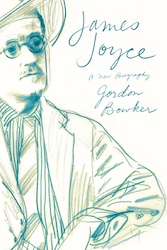
James Joyce: A New Biography
By Gordon Bowker
Farrar, Straus and Giroux, 2012
Available online at: Internet Archive
Gordon Bowker (1934-2019) was an English writer and journalist known for his biographies of Malcolm Lowry and George Orwell. A lecturer at Goldsmith’s College, Bowker was also active in the British entertainment industry, having written numerous radio plays and television documentaries. His last published book was James Joyce: A New Biography. For some inexplicable reason, the press materials claim Bowker’s book is the first new Joyce biography since Richard Ellmann’s…an interesting oversight that leaves several excellent works in the lurch!
Publisher’s Description: A revealing new biography—the first in more than fifty years—of one of the twentieth-century’s towering literary figures. Gordon Bowker draws on material recently come to light and reconsiders the two signal works produced about Joyce’s life―Herbert Gorman’s authorized biography of 1939 and Richard Ellman’s magisterial tome of 1959―and, most importantly by binding together more intimately than has ever before been attempted the life and work of this singular artist, Gordon Bowker here gives us a masterful, fresh, eminently readable contribution to our understanding, both of Joyce’s personality and of the monumental opus he created. Bowker goes further than his predecessors in exploring Joyce’s inner depths―his ambivalent relationships to England, to his native Ireland, and to Judaism―uncovering revealing evidence. He draws convincing correspondences between the iconic fictional characters Joyce created and their real-life models and inspirations. And he paints a nuanced portrait of a man of enormous complexity, the clearest picture yet of an extraordinary writer who continues to influence and fascinate over a century after his birth. Widely acclaimed on publication in Britain last year, perhaps the highest compliment paid was by Chris Proctor, of London’s Tribune: “Bowker’s success is to lead you back to the texts, perhaps understanding them better for this rich account of the maddening insane genius who wrote them.”
The Life and Legacy of James Joyce: Pioneer of Modern Literature
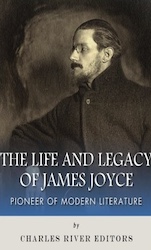
The Life and Legacy of James Joyce: Pioneer of Modern Literature
By The Charles River Editors
CreateSpace Independent Publishing Platform, 2013
Also available as: Audible Audiobook
At first glance, Charles River’s Life and Legacy of James Joyce looks pretty bleak. It’s independently published, and there’s no named authorship—just “The Charles River Editors.” There’s also the terrible promotional copy to contend with: “The Life and Legacy of James Joyce profiles the life and career of one of America’s most famous entertainers. You will learn about Joyce like you never have before, in no time at all.”
Yes…one of America’s most famous entertainers…no time at all… Clearly some marketing genius just dropped “James Joyce” into a boilerplate while gossiping on Slack about Carol from Accounting’s latest Twitter flameout. However, once these red flags have been waved aside, the book itself is a surprisingly decent introduction to James Joyce. Clocking in at 36 pages, its brevity belies its ambitious title, but the editors do a credible job, bullet-pointing the highlights of Joyce’s biography using quotations, photographs and images, and pithy sentences such as, “James Joyce was born into the usual stultifying Irish environment that is now a cliché of a thousand movies.” There’s a kind of brisk irony to the writing, and while clearly intended as in introduction to the uninitiated, the book rarely condescends. Sentences like “Joyce went through a brief era of religious devotion and ecstasy before turning his attention almost wholly to art, after which he began writing poems and prose pieces to try to express his still inchoate feelings” may trade accuracy for concision, but are clearly not written for the “Joyce for Dummies” crowd! You can do worse for $5.
Publisher’s Description: James Joyce is the high priest of modernist writing who lived a life of endless sacrifice to literature, loaded with poverty and petty humiliations. He blazed the path of the writer as resolute individualist, rejecting all conformity and risking everything, even public shaming, in order to “communicate” over the supine body of language with his enthralled readers. He once remarked to his younger brother Stanislaus, “Don’t you think there is a certain resemblance between the mystery of the Mass and what I am trying to do? I mean that I am trying…to give people some kind of intellectual pleasure or spiritual enjoyment by converting the bread of everyday life into something that has a permanent artistic life of its own…for their mental, moral, and spiritual uplift.” Joyce pioneered modern literature through his use of stream of consciousness, a literary technique that lets readers get straight into the mind of the book’s characters and stands in stark contrast to Ernest Hemingway’s “iceberg” style of leaving things to the readers’ imaginations. In his masterpiece Ulysses, Joyce explores several topics and thoughts that go through the mind of one man in Dublin for a day, and he also wrote other critically-acclaimed works such as the short-story collection Dubliners (1914), and the novels A Portrait of the Artist as a Young Man (1916) and Finnegans Wake (1939). He said of his frequent use of Dublin as a setting, “For myself, I always write about Dublin, because if I can get to the heart of Dublin I can get to the heart of all the cities of the world. In the particular is contained the universal.” The Life and Legacy of James Joyce: Pioneer of Modern Literature profiles the life and career of one of America’s most famous entertainers. You will learn about Joyce like you never have before, in no time at all.
James Joyce: Portrait of a Dubliner
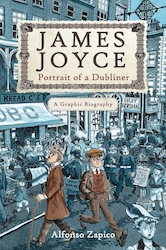
James Joyce: Portrait of a Dubliner
By Alfonso Zapico
Arcade, 2018
Publisher’s Description: Winner of Spain’s National Comic Prize and published to acclaim in Ireland, here is an extraordinary graphic biography of James Joyce that offers a fresh take on his tumultuous life. With evocative anecdotes and hundreds of ink-wash drawings, Alfonso Zapico invites the reader to share Joyce’s journey, from his earliest days in Dublin to his life with his great love, Nora Barnacle, and their children, and his struggles and triumphs as an artist. Joyce experienced poverty, rejection, censorship, charges of blasphemy and obscenity, war, and crippling ill-health. A rebel and nonconformist in Dublin and a harsh critic of Irish society, he left Ireland in self-imposed exile with Nora, moving to Paris, Pola, Trieste, Rome, London, and finally Zurich. He overcame monumental challenges in creating and publishing Dubliners, Portrait of an Artist as a Young Man, Ulysses, and Finnegans Wake. Along the way, he encountered a colorful cast of characters, from the Irish nationalists Charles Parnell and Michael Collins to literary greats Yeats, Proust, Hemingway, and Beckett, and the likes of Carl Jung and Vladimir Lenin.
James Joyce In Zurich: A Guide
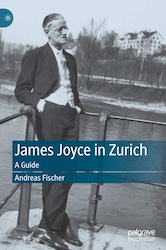
James Joyce In Zurich: A Guide
By Andreas Fischer
Palgrave Macmillan, 2021
Publisher’s Description: This book offers a comprehensive account of James Joyce and Zurich, one of the four cities (including Dublin, Trieste and Paris) in which he spent significant parts of his life. As a refugee during World War I, Joyce wrote a substantial part of Ulysses in Zurich and subsequently visited the city regularly during the 1930s. Finally, a refugee for the second time, he died there on 13 January 1941 and is buried in Fluntern Cemetery. This guide is conceived both as a book that may be read in its entirety or consulted selectively for specific information. An introduction and three chapters, “Joyce in Zurich,” “Zurich in Joyce” and “Zurich after Joyce,” are followed by sixty alphabetically ordered articles on people, places, institutions and events relevant to Joyce during his time in Zurich. Linked by cross-references and an index, they provide a rich, kaleidoscopic view of Joyce’s Zurich.
James Joyce: A Very Short Introduction

James Joyce: A Very Short Introduction
By Colin MacCabe
Oxford University Press, 2022
Also available as: Audible Audiobook
Born in 1949, Colin MacCabe is a British writer and film producer who currently teaches literature and film at the University of Pittsburgh. MacCabe received his PhD from Trinity College, his dissertation being James Joyce and the Revolution of the Word, which was published as a book in 1978. In 1982 MacCabe edited the essay collection, James Joyce: New Perspectives. He’s also written extensively on film, especially the work of Jean-Luc Godard.
Publisher’s Description: This “Very Short Introduction” explores the work of this most influential yet complex writer, and analyses how Joyce’s difficulty grew out of his situation as an Irish writer unwilling to accept the traditions of his imperialist oppressor, and contemptuous of the cultural banality of the Gaelic revival. Joyce wanted to investigate and celebrate his own life, but this meant investigating and celebrating the drunks of Dublin’s pubs and the prostitutes of Dublin’s brothels. No subject was alien to him and he developed the naturalist project of recording all aspects of life with the symbolist project of finding significant correspondences in the most unlikely material. Throughout, Colin MacCabe interweaves Joyce’s life and history with his books, and draws out their themes and connections.
Joyce Biography
[Main Page | Biographical Sketch | Chronology | Joyce Biographies | Family & Associates | Memoirs & Photos | Letters | Dublin]
Author: Allen B. Ruch
Last Modified: 15 June 2024
Main Joyce Page: The Brazen Head
Contact: quail(at)shipwrecklibrary(dot)com

